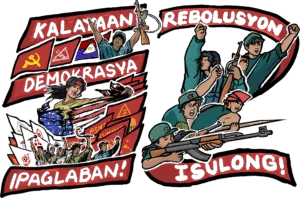3. Aftermath of World War II, 1946 to 1959
After proclaiming the independence of Vietnam in 1945, the Viet Minh formed the National Assembly in January 1946. The French government recognized the Democratic Republic of Vietnam as a free state of the French Union in March 1946 but declared war against it in November of the same year and began the First Indochina War. It set up the puppet government of Bao Dai in Saigon in 1948. The people's army of the Democratic Republic of Vietnam strengthened its bases in northern Vietnam and gained support from the victorious Chinese Communist Party in 1949.
In 1951 the Indochinese Communist Party decided to divide into three parties in to order let them focus on the problems in their respective countries. The kingdoms of Cambodia and Laos were recognized by France as "independent states" of the French Union in 1953. In the name of the Cold War, the US started to give substantial political and financial support to the French war effort in 1949 and at the same time increased its influence among prospective Vietnamese puppets. The Vietnamese people's army defeated the French at Dien Bien Phu in 1954 on the eve of the Geneva Conference.
The Geneva Conference of 1954 agreed to divide Vietnam into North and South temporarily and to reunite it after elections in 1956. But the US-supported Ngo Dinh Diem regime that had deposed the Bao Dai regime in 1955 refused to hold elections. Following orders from the US, it declared South Vietnam a republic. A Filipino lawyer asset of the US Central Intelligence Agency drafted the constitution of the phoney republic.
The Ngo regime unleashed a reign of terror against the Viet Minh, the people and all opposition forces, including patriotic religious organizations. Local revolts occurred in 1957. A full scale civil war developed in 1959. This began the Second Indochina War, in which the US increased its military intervention until this became a full-scale war of aggression.
Following the declaration of Indonesian national independence in 1945, Indonesian president Sukarno proceeded to call for national unity to fight against the British military forces and thereafter the Dutch military forces who sought to reconquer Indonesia. At first, he relied mainly on the disciplined and battle-tested guerrilla forces of the Communist Party of Indonesia and on the left-wing and youth section of the Partai Sosialis Indonesia. But he and his vice president Hatta increasingly relied on the pro-US and pro-Western military officers, including those who had served in the Japanese occupation army. The communists were massacred in Madiun in 1948 to make way for the neocolonial compromise in the Round Table Conference Agreement.
Challenged by the US and pro-US forces and ultra-reactionary forces in Indonesia represented by Hatta and the right wing forces of the Masjumi and Socialist Party, Sukarno sought once more the alliance of the Communist Party of Indonesia in 1951. The Communist Party of Indonesia ordered its remaining armed units to disband and appeared to thrive politically by pursuing the peaceful and parliamentary road of struggle and by keeping an anti-imperialist alliance with Sukarno and his nationalist following.
It was able to increase its party membership, rapidly build large mass organizations and won 16.4 per cent of the votes in the 1955 elections. It was able to stand up against the US military intervention and armed rebellions of the pro-US ultra-reactionary forces in 1958. In this connection, it was able to build militia units and gain followers and influence within the military and police of the Sukarno government. But subsequently, it agreed to relinquish leadership over its armed units and submit them for integration in the Indonesian army. The Communist Party of Indonesia became bound to the Right opportunist and revisionist line of legalism and parliamentarism and wishing to enlarge the "pro-people aspect" of the Indonesian semi-colonial state of the big compradors and landlords.
The old merger party of the Communist and Socialist parties pushed for and welcomed the grant of nominal national independence to the Philippines by the US in 1946. It agreed with the reactionary authorities to demobilize the people's army and surrender its arms despite the rising brutal acts of the US and local reactionary forces against units of the people's army and the peasants who had undertaken land reform during the Japanese occupation. It was heavily influenced by the Browderite line of peace and democracy. It formed the Democratic Alliance to compete in the electoral struggle.
The Democratic Alliance won enough seats in Congress in 1946 to prevent the passage of an amendment in the 1935 Constitution for the purpose of allowing US corporations and citizens to have rights at par with the Filipinos in exploiting Philippine natural resources and operating public utilities. The puppet government ousted from Congress the progressive members on false charges of electoral fraud and terrorism. Moreover, the brutal attacks on the people in the revolutionary areas escalated. Thus, the ground was laid for a decision of the old merger party in 1948 to start revolutionary armed struggle. But only in the latter half of 1950 was the people's army able to launch some relatively large offensives on a wide scale along the Sierra Madre mountain range.
The "Left" opportunist line of seeking to win complete victory in two years' time without painstaking mass work, without land reform and without building the people's army in stages but relying on the growth of the spontaneous uprising of the people due to the severe crisis of the system and violent contradictions among the reactionaries proved disastrous. The enemy was able to launch a sustained counter-attack against the forest-based camps of the people's army and capture most of the city-based principal leaders in 1950-52. Since then, the old merger party swung back to Right opportunism, including the orders to liquidate the people's army in 1955 and the party in 1957, and caused the party to become moribund, until efforts were made to revive it from 1959 onwards.
The British colonialists legalized the Malayan People's Anti-Japanese Army but banned it in 1948 and declared a state of emergency in order to suppress it. Peace talks between the Malayan communist leaders and the chief ministers of Malaya and Singapore broke down as the latter officials demanded the dissolution of the Malayan Communist Party. The state of emergency was ended in 1960 after the authorities estimated that they had virtually crushed the people's army. But in fact this continued to fight from a relatively secure area along the Thailand-Malaya border area.
After being expelled from the Anti-Fascist People's Freedom League in 1946, the Burmese Communist Party launched an armed revolution in 1948. It operated mainly in Central Burma and the in the Arakan mountains and Irrawaddy delta. It engaged in alliances with the minority nationalities that were also waging armed struggle against the Burmese reactionary government. It engaged in peace negotiations withn this government in 1958 but these did not stop the people's war.
The people's armies led by communist parties in Southeast Asia stood their ground against the attempts of the old Western colonial powers to reconquer and reimpose their rule on their former colonies. The people's armies were also resolutely and vigorously against the attempts of the US to expand its hegemony. The resounding victories of China against the US-Guomindang tandem inspired the communist parties of Southeast Asia to engage in people's war. The US became more aggressive in carrying out the Cold War in Asia from 1948 onwards as well as in unleashing the wars of aggression against Korea in 1951-53 and in the next decade in Vietnam.

